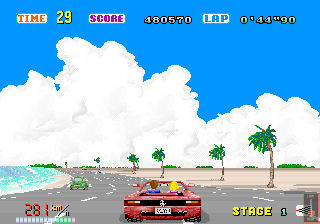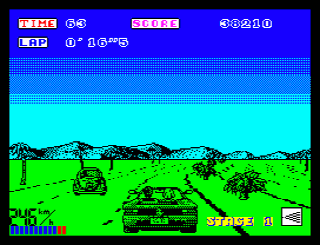(Note: part 1 is here.)
Moving on to 16-bit home computer versions of Out Run, there are just three to look at.
Let’s begin with the one I believe came out first, the Atari ST version, released by US Gold in 1988:
Oh dear. As you can see… not very good. I’m pretty sure that this is the Spectrum / Amstrad CPC code simply ported to the ST, without using any of its more advanced features or any programming tricks. The game feels exactly like the Spectrum version, the roads are exactly the same, and so on; only the graphics are new (and pretty bad for an ST), and the game is faster simply because the CPU is faster (but still not as fast or smooth as the hypothetical “7 Mhz Spectrum”, which you can try by setting a Speccy emulator to 200% speed). Note also that the music is exactly the same as in the Spectrum version, which makes sense as both machines have the same sound hardware; however, the ST, because of its extra speed and storage, could have used samples (like many of its games did), and no such thing happened here. Or, you know, actually include the third song from the arcade, since there’s memory and disk space to spare. In short: another lazy port. It’s simply the Spectrum game running on a faster machine and with more color.
Now, for the Amiga version, also by US Gold, released in 1988:
Ouch! It’s the Atari ST version, with different music — this time, the sound chip is different, so they couldn’t just port the Spectrum tunes –, but, in my opinion, it also sounds worse — which is even sadder when you consider how good Amiga music often was. Also, again, it’s the same code as the ST version, with no Amiga features used — which means the game is even slower, as the Amiga’s CPU runs at a lower frequency than the ST’s; usually that was more than compensated by the Amiga’s co-processors, but it’s obvious that they’re standing idle, here. Once again, an incredibly lazy port.
Incidentally, the Amiga version allows sound effects and music at the same time, but the author of the video turned them off before starting the game, and with good reason: they’re terrible. Also, the game seems able to play only one sound effect at the time, so, for instance, when you’re skidding, the engine sound is actually temporarily turned off. On an Amiga. 😯
Finally, we come to the PC (MS-DOS) version, released in 1989 by Sega:
Much like the MSX2 version (see part 1), also by Sega, it’s closer to the Master System version, with little resemblance to the US Gold ports (which, except for the C64 version, all seem to share the same algorithms and maps). It’s fast, smooth and colorful, but the sprites are smaller, and the game feels “emptier”, both in terms of roadside objects and other cars (the smallness of the sprites probably helps). Being an old PC game, it’s limited in terms of hardware, supporting only up to EGA graphics (16-color, with probably the worst palette you can imagine) and PC speaker sound.
It’s probably the best of the three 16-bit home computer ports… but still not a very good one, in my opinion. To see one (if we don’t count the extremely playable but not very “Outrunnish” C64 port), we’ll have look among console ports, which is the subject of part 3.

